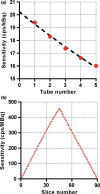Performance evaluation of the 5-Ring GE Discovery MI PET/CT system using the national electrical manufacturers association NU 2-2012 Standard
- PMID: 31069816
- PMCID: PMC7251507
- DOI: 10.1002/mp.13576
Performance evaluation of the 5-Ring GE Discovery MI PET/CT system using the national electrical manufacturers association NU 2-2012 Standard
Abstract
The GE Discovery MI PET/CT system has a modular digital detector design allowing three, four, or five detector block rings that extend the axial field-of-view (FOV) from 15 to 25 cm in 5 cm increments. This study investigated the performance of the 5-ring system and compared it to 3- and 4-ring systems; the GE Discovery IQ system that uses conventional photomultiplier tubes; and the GE Signa PET/MR system that has a reduced transaxial FOV.
Methods: PET performance was evaluated at three different institutions. Spatial resolution, sensitivity, counting rate performance, accuracy, and image quality were measured in accordance with National Electrical Manufacturers Association NU 2-2012 standards. The mean energy resolution, mean timing resolution, and PET/CT subsystem alignment were also measured. Phantoms were used to determine the effects of varying acquisition time and reconstruction parameters on image quality. Retrospective patient scans were reconstructed with various scan durations to evaluate the impact on image quality.
Results: Results from all three institutions were similar. Radial/tangential/axial full width at half maximum spatial resolution measurements using the filtered back projection algorithm were 4.3/4.3/5.0 mm, 5.5/4.6/6.5 mm, and 7.4/5.0/6.6 mm at 1, 10, and 20 cm from the center of the FOV, respectively. Measured sensitivity at the center of the FOV (20.84 cps/kBq) was significantly higher than systems with reduced axial FOV. The peak noise-equivalent counting rate was 266.3 kcps at 20.8 kBq/ml, with a corresponding scatter fraction of 40.2%. The correction accuracy for count losses up to the peak noise-equivalent counting rate was 3.6%. For the 10-, 13-, 17-, 22-, 28-, and 37-mm spheres, contrast recoveries in the image quality phantom were measured to be 46.2%, 54.3%, 66.1%, 71.1%, 85.3%, and 89.3%, respectively. The mean energy and timing resolution were 9.55% and 381.7 ps, respectively. Phantom and patient images demonstrated excellent image quality, even at short acquisition times or low injected activity.
Conclusion: Compared to other PET/CT models, the extended axial FOV improved the overall PET performance of the 5-ring GE Discovery MI scanner. This system offers the potential to reduce scan times or injected activities through increased sensitivity.
Keywords: Discovery MI-5 ring scanner; NEMA NU 2; PET/CT; instrumentation; performance characterization.
© 2019 American Association of Physicists in Medicine.
Conflict of interest statement
The authors have no financial conflicts of interest related to the material presented in this article.
Figures








References
-
- Schatka I, Weiberg D, Reichelt S, et al. A randomized, double‐blind, crossover comparison of novel continuous bed motion versus traditional bed position whole‐body PET/CT imaging. Eur J Nucl Med Mol Imaging. 2016;43:711–717. - PubMed
MeSH terms
Grants and funding
LinkOut - more resources
Full Text Sources
Research Materials

